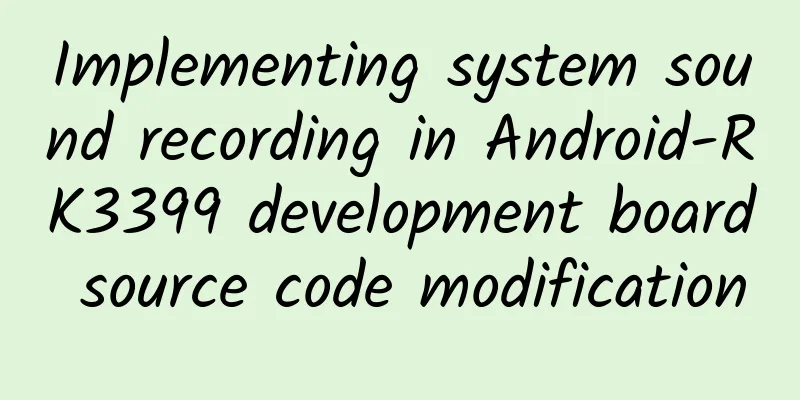Implementing system sound recording in Android-RK3399 development board source code modification

Preface
1. Simple Implementation of RecordingAudioRecord audioRecord = new AudioRecord ( MediaRecorder . AudioSource . REMOTE_SUBMIX 2. Introduction to AudioSource input sourcepublic final class AudioSource {
3. Source code modification1. Screen recording on Android 10 and belowframeworks \av \services \audiopolicy \enginedefault \src \Engine . cpp Modified to: if ( mAvailableOutputDevices . getDevice ( AUDIO_DEVICE_OUT_REMOTE_SUBMIX , String8 ( "0" )) != 0 ) { 2. Android 11targetframeworks \av \services \audiopolicy \enginedefault \src \Engine . cpp Modified to: if (( remoteSubmix = availableOutputDevices . getDevice ( ConclusionTo record system sound on Android, it is not available under normal circumstances. This solution is to modify the source code to achieve it. Later I can introduce how the system is implemented, and post the source code so that we can learn together. |
>>: Taro cross-terminal solution for Ctrip’s mini-program ecosystem
Recommend
There have been multiple cases of hemorrhagic fever in Xi'an. Is it related to eating strawberries?
Recently, Xi'an has become a hot topic due to...
The college entrance examination papers were printed in prison? What happened? Revealed!
The annual college entrance examination kicked of...
Wang Nan·Short video shooting + editing (updating)
After studying the course [Wang Nan·Short Video S...
Kuaishou operation, analysis of operation steps!
Want to play Kuaishou easily? Follow Jun Ge, the ...
Does personality determine life expectancy? Cancer prefers type C personality? The sooner you know this, the better.
Expert of this article: Wang Xiaohuan, Doctor of ...
If people can reach the speed of light, what will they see? The color of the world will become different
Why can we see this colorful world? Because of li...
The forms and methods of Zhihu promotion
Zhihu’s advertising formats are diverse, includin...
Is the habit of “rinsing mouth with tea” in “Dream of Red Mansions” good or bad?
□ Tong Yun Cao Xueqin wrote in Dream of the Red C...
Can you buy your privacy for 300 yuan?! How terrible is "opening the box"...
Is your privacy still safe? Do you dare to believ...
Apple saves the 2013 MacBook Air
Although the 2013 MacBook Air is the best product ...
How to operate content-based products? These 5 steps will solve everything!
Currently in the mobile Internet market, most pro...
Top ten crisis public relations events in 2018!
Looking back at the year 2018, the public relatio...
Xiaomai: I can’t hold on any longer. I’ll fall down first.
Review expert: Xia Xiaofei, Secretary General of ...
Should you remove the foam from stewed meat or soup? You may miss the real "essence"
People who cook regularly know When making soup o...
WeChat has developed secure payment-level facial recognition: You can spend money even when wearing a mask
With the arrival of winter, concerns about the ne...









